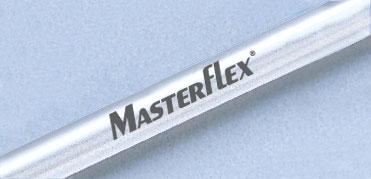Tubos de silicona de Masterflex

Our silicone tubing comes in two formulations: peroxide- and platinum-cured. Both formulations share many characteristics, such as FDA compliance and USP Class VI approvals, temperature ratings, and chemical compatibility. However, there are some differences between the two silicone types.
Peroxide-cured silicone tubing
Advantages:
- Greater physical compression capability
- Economical
- Longer tubing life
Disadvantages:
- Potential outgassing of peroxide products
Platinum-cured silicone tubing
Advantages:
- Slightly greater clarity
- Smoother surface and lower level of protein binding
- Preferred by pharmaceutical and biotechnology industries
- Fewer potential leachables
Disadvantages:
- Shorter tubing life
These two types of silicone tubing are so different due to the process used in manufacturing. This process is known as vulcanization. The following describes the process that these types of tubing go through.
Vulcanization of Siloxane: Silicone curing
Silicone tubing is derived from the siloxane polymer polydimethyl siloxane. This polymer is an amorphous flowable substance which does not have useful tubing properties. By adding a catalyst which causes the siloxane polymer to cross-link, and adding silica filler for strength, the elastomer silicone is formed. The processes by which siloxane is converted to silicone are known as vulcanization or curing. There are two commercially significant curing processes, peroxide-curing and platinum-curing.
Platinum-cured tubing
This curing process occurs at room temperature, hence it is also known as Room Temperature Vulcanization (RTV). A platinum salt is added to siloxane as it is being extruded. Once this mixture is exposed to air cross-linking begins and silicone is formed. The by-product of this reaction is ethanol which is easily removed. The silicone material formed by platinum-curing is generally not as strong as that formed by peroxide-curing.
Peroxide-cured tubing
In this curing process, the siloxane polymer is blended with an organic peroxide. The tubing is extruded and then heated. Heat initiates the cross-linking, forming silicone. Catalytic by-products (peroxides and ketones) are volatile and evaporate during the cure process. If not properly cured, or over long periods of time, outgassing of peroxides and ketones may occur. The major symptom of outgassing is blooming, or a fine white crystalline powder forming on the inside of the tubing. This may be removed by heating the tubing and then rinsing it.
Although both of these types of tubing have been produced in a clean environment, it has not been pre-sterilized. This is the responsibility of the user. Below are a couple of methods to consider if sterilization is a requirement for your procedures.
To Sterilize Silicone Tubing
- High-speed instrument (flash) autoclave: Place tubing on nonlinting cloth or sterilizing paper in a clean, open tray for 10 minutes at 270 deg F (132 deg C) at 30 psi (2 kg/sqcm).
- Standard gravity autoclave: Wrap tubing in nonlinting cloth or sterilizing paper and place in a clean, open tray for 30 minutes at 250 deg F (121 deg C) at 15 psi (1 kg/cm2).
- Prevacuum high-temperature autoclave: Wrap tubing in nonlinting cloth or sterilizing paper and place in a clean, open tray for normal cycle of 30-35 minutes at 250 deg F (121 deg C).
- Gamma radiation.